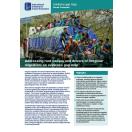Mapping the evidence on social, behavioural and community engagement for reproductive, maternal, newborn, child and adolescent health
This brief combines the findings from the evidence gap map on adolescent, sexual and reproductive health and the social
Context
Over the last few decades, there have been significant improvements in the health and well-being of women, adolescents and children, however, gains have been uneven and inequalities persist.
Social,
To support the implementation of effective and sustainable
To bring the findings of these two projects together, the World Health
The brief pulls together findings from the following two EGM reports:
- Social,
behavioural and community engagement interventions for reproductive, maternal, newborn and child health: evidence
gap map - Adolescent sexual and reproductive health evidence gap map report: In this report, SBCE interventions are examined within a broader framework of interventions. This report was produced by 3ie.
Main findings from the RMNCH and ASRH gap maps
We find that while a considerable amount of evidence already exists for SBCE interventions for RMNCH and ASRH, there are still critical gaps in the impact evaluation and systematic review evidence bases.
We identified a number of limitations common across studies in this literature. These should be considered in the design and reporting of future impact evaluations and systematic reviews to help improve and advance research on SBCE interventions:
- Studies rarely report on outcomes related to the enabling environment, such as health provider attitudes and communication skills, or social norms;
- Analysis of how SBCE intervention effects vary by vulnerable or
marginalised populations is frequently missing; - M-health and other ICTs play an increasingly stronger role in SBCE programming, but there is limited evaluation evidence available;
- The usefulness of studies is often limited by inadequate reporting,
including in descriptions of context of the evaluation, interventions and study design; - Few of the studies included qualitative components or process evaluation
- It was rare for studies to include information on cost or cost effectiveness analysis;
- There are very few evaluations of interventions in
francophone African countries, despite evidence of SBCE programming in this region; and - A significant share of the systematic review evidence base has methodological limitations. These limitations include unclear inclusion criteria for interventions and health topics, no use of independent screening or data extraction, missing risk of bias assessments of included studies and use of vote-counting approaches.
Use the links below to access 3ie’s interactive EGM platform
Explore the evidence gap maps on 3ie’s interactive platform
ASRH evidence gap map
RMNCH evidence gap map
To explore the EGMs by health area:
Reproductive health evidence gap map
Maternal health evidence gap map
Newborn health evidence gap map
Child health evidence gap map
Key publications
Download the 3ie ASRH EGM report
Download the 3ie brief on SBCE interventions




